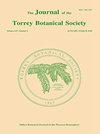Blowdown Dynamics in Oak-Hickory Forests of the Missouri Ozarks
IF 0.8
4区 生物学
Q4 PLANT SCIENCES
引用次数: 27
Abstract
REBERTUS, ALAN J. AND ALBERT J. MEIER (School of Natural Resources, University of Missouri, Columbia, MO 65211) Blowdown Dynamics in Oak-Hickory Forests of the Missouri Ozarks. J Torrey Bot. Soc. 128:362369. 2001.-Several studies in the literature have relied on public land survey (PLS) notes from the 1800's to reconstruct historical blowdown rates in eastern deciduous-conifer forests, but assessment of contemporary blowdown regimes in the region has not received much attention. We used an approach similar to the PLS method, and sampled 105 km of transect to determine whether oak (Quercus) dieback led to extensive secondary blowdown of patches 2500 m2 in 50to 100-year-old oak-hickory forests in the Missouri Ozarks. Few studies of wind disturbance have focused on even-aged, second-growth stands, even though such stands predominate in eastern deciduous forests. From 1986-1996, blowdowns 2500 m2 disturbed 1.42% of the landscape; for patches 0.05-2.5 ha, only 0.63% of the landscape was disturbed. Although extensive oak dieback occurred in the 1980's and 90's, most of the decline was distributed diffusely through stands, and coarser patches of windthrow were uncommon. Shade-intolerant scarlet oaks (Quercus coccinea Muenchh.) dominated the pre-disturbance canopy and were the dominant treefalls, but two-thirds of new regeneration in blowdowns consisted of white oaks (Quercus alba L.), hickories (Carya spp. L.), and flowering dogwoods (Cornus florida L.). Blowdowns appeared to leave the understory intact, favoring future dominance by species with intermediate shade tolerance.密苏里州奥扎克橡树-山核桃林的排污动力学
REBERTUS, ALAN J.和ALBERT J. MEIER(密苏里大学自然资源学院,哥伦比亚,密苏里州65211)密苏里州奥扎克橡树山核桃森林的排放动力学。J·托里·博特。128:362369 Soc。2001.-文献中的几项研究依赖于19世纪的公共土地调查(PLS)记录来重建东部落叶针叶林的历史排灌率,但对该地区当代排灌制度的评估并未受到太多关注。我们使用了一种类似PLS方法的方法,并对105公里的样带进行了采样,以确定在密苏里州奥扎克地区50至100年历史的橡树山核桃林中,橡树(栎树)枯死是否导致了2500平方米的大面积次生污染。很少有关于风干扰的研究集中在平均年龄的次生林上,尽管这类林分在东部落叶林中占主导地位。1986-1996年,2500平方米的排污破坏了1.42%的景观;在0.05 ~ 2.5 ha的斑块中,只有0.63%的景观受到干扰。虽然在20世纪80年代和90年代发生了广泛的栎树枯死,但大部分的下降是通过林分扩散分布的,而粗糙的风阻斑块并不常见。不耐阴的红栎树(Quercus coccinea Muenchh.)在干扰前的林冠层中占主导地位,是主要的树木,但三分之二的新更新由白栎树(Quercus alba L.)、山核桃(Carya spp. L.)和开花山茱萸(Cornus florida L.)组成。吹落似乎使林下植被保持完整,有利于具有中等遮荫耐性的物种在未来占据优势地位。
本文章由计算机程序翻译,如有差异,请以英文原文为准。
求助全文
约1分钟内获得全文
求助全文
来源期刊
CiteScore
0.70
自引率
0.00%
发文量
16
审稿时长
>12 weeks
期刊介绍:
The Journal of the Torrey Botanical Society (until 1997 the Bulletin of the Torrey Botanical Club), the oldest botanical journal in the Americas, has as its primary goal the dissemination of scientific knowledge about plants (including thallopyhtes and fungi). It publishes basic research in all areas of plant biology, except horticulture, with an emphasis on research done in, and about plants of, the Western Hemisphere.

 求助内容:
求助内容: 应助结果提醒方式:
应助结果提醒方式:


